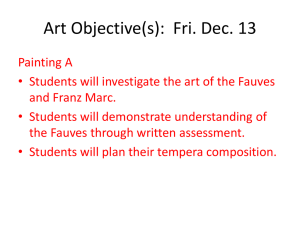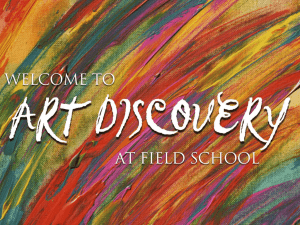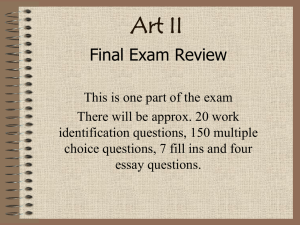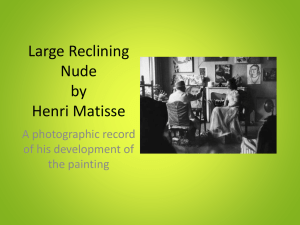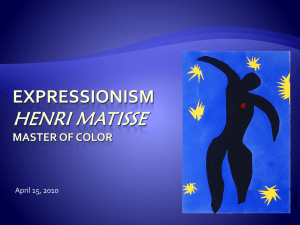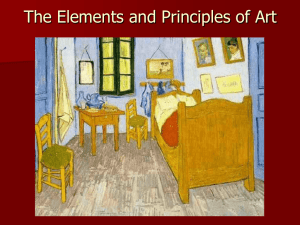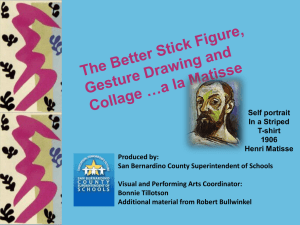CHAPTER 24 Turn of the Century: Early Picasso, Fauvism
advertisement
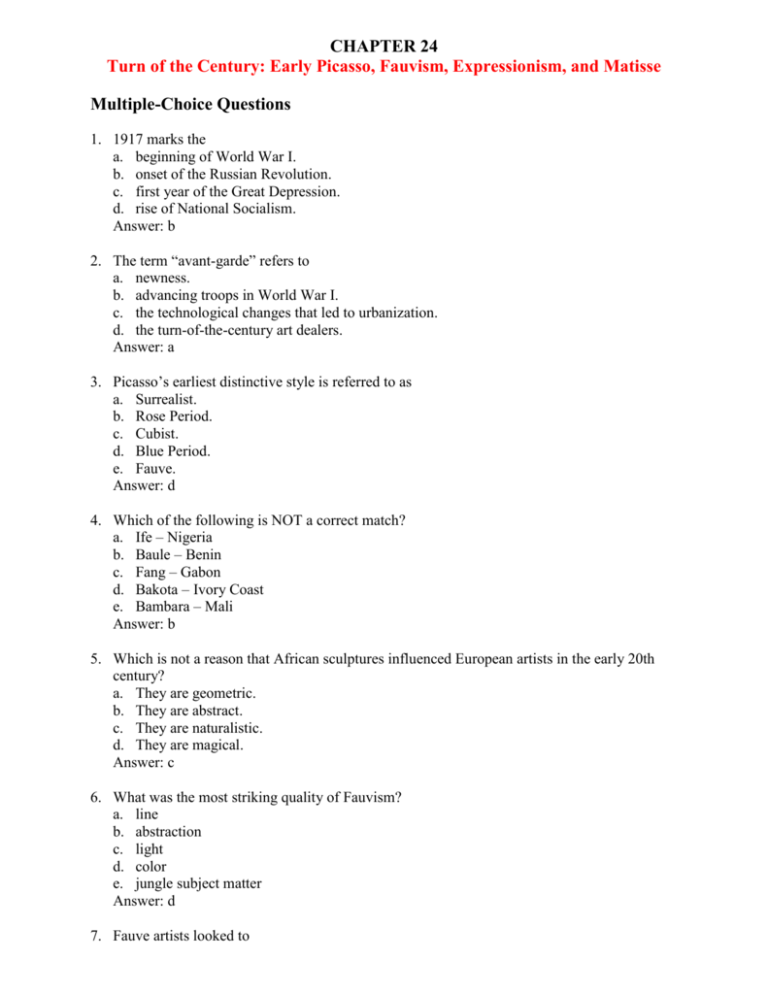
CHAPTER 24 Turn of the Century: Early Picasso, Fauvism, Expressionism, and Matisse Multiple-Choice Questions 1. 1917 marks the a. beginning of World War I. b. onset of the Russian Revolution. c. first year of the Great Depression. d. rise of National Socialism. Answer: b 2. The term “avant-garde” refers to a. newness. b. advancing troops in World War I. c. the technological changes that led to urbanization. d. the turn-of-the-century art dealers. Answer: a 3. Picasso’s earliest distinctive style is referred to as a. Surrealist. b. Rose Period. c. Cubist. d. Blue Period. e. Fauve. Answer: d 4. Which of the following is NOT a correct match? a. Ife – Nigeria b. Baule – Benin c. Fang – Gabon d. Bakota – Ivory Coast e. Bambara – Mali Answer: b 5. Which is not a reason that African sculptures influenced European artists in the early 20th century? a. They are geometric. b. They are abstract. c. They are naturalistic. d. They are magical. Answer: c 6. What was the most striking quality of Fauvism? a. line b. abstraction c. light d. color e. jungle subject matter Answer: d 7. Fauve artists looked to a. Polynesian and African sculpture. b. the colors of Gauguin and van Gogh. c. folk textiles and ceramics. d. All these answers are correct. Answer: d 8. The Green Line is a painting of a. Madame Matisse. b. a Paris street. c. Horses. d. Icarus. e. a still life. Answer: a 9. As far as joy and spontaneity, ________’s art followed its own muses. a. Barlach b. Tatlin c. Matisse d. Picasso Answer: c 10. Matisse worked toward ________ in his art. a. balance b. purity c. serenity d. All these answers are correct. Answer: d 11. Die Brücke refers to a. a German painting of a bridge. b. a German painting of a street. c. a German art movement. d. a German artist. Answer: c 12. Kirchner was influenced by a. African sculpture. b. medieval woodcuts. c. the city and its crowd. d. All these answers are correct. Answer: d 13. Worringer is the author of a. Abstraction and Empathy. b. The Principles of Art History. c. Die Brücke. d. Der Blaue Reiter. Answer: a 14. Nolde’s style is best described as a. Fauve. b. Cubist. c. Symbolist. d. Expressionist. Answer: d 15. Which is true of Franz Marc’s views of color? a. yellow was sunny and cheerful b. blue was depressive c. red was aggressive d. gray was reserved for trees Answer: c 16. Which is NOT true of Kollwitz? a. she came from a financially comfortable family b. she thought of herself as an Expressionist c. she depicted the problems of the working classes d. she sympathized with German peasants e. her textures tend to be harsh Answer: b 17. Matisse’s arabesques refer to a. dancers. b. musicians. c. a kind of black curve. d. bright colors. Answer: c 18. Matisse’s Decorative Figure in an Oriental Setting is set in a. Morocco. b. the Far East. c. Easter Island. d. Oceania. e. Tahiti. Answer: a 19. Matisse’s Jazz imagery is an example of a. Symbolism. b. Fauvism. c. découpage. d. Cubism. e. the Blue Rider. Answer: c 20. The Oba was a a. tribal magician. b. divine king. c. Benin shaman. d. Fang god. Answer: b 21. The “Punitive Expedition” sent to Benin was a. Portuguese. b. French. c. Dutch. d. British. e. Nigerian. Answer: d 22. Which artist is correctly matched with his or her nationality? a. Marc – French b. Matisse – Moroccan c. Kandinsky – Russian d. Nolde – Dutch e. Picasso – French Answer: c 23. As far as one can tell, the first completely non-figurative painter was a. Kandinsky. b. Marc. c. Matisse. d. Picasso. e. Nolde. Answer: a 24. ________ admired animals and celebrated them in his work in Der Blaue Reiter. a. Ernest Barlach b. Paul Gauguin c. Wassily Kandinsky d. Franz Marc Answer: d 25. 1914–1918 are the dates of a. World War II. b. the American Civil War. c. the Russian Revolution. d. World War I. e. the Franco-Prussian War. Answer: d 26. Which artist is correctly matched with his work? a. Kirchner – Large Blue Horses b. Matisse – Jeannette V c. Kandinsky – Notre-Dame in the Late Afternoon d. Picasso – Still Life with Masks e. Gauguin – Five Women in the Street Answer: b 27. The first Fauve exhibit was held in a. 1905. b. 1906. c. 1900. d. 1910. Answer: a Key Works Pablo Picasso, Old Guitarist, 1903 Henri Matisse, Notre-Dame in the Late Afternoon, 1902 Henri Matisse, Madame Matisse (The Green Line), 1905 Henri Matisse, Woman with the Hat, 1905 Henri Matisse, The Joy of Life, 1905–1906 Ernst Ludwig Kirchner, The Street, 1908 Ernst Ludwig Kirchner, Potsdamer Platz, 1914 Emil Nolde, Still Life with Masks, 1911 Emil Nolde, drawing of an Oceanic canoe prow, 1911, for left-hand mask in Still Life with Masks Vassily Kandinsky, Panel for Edwin R. Campbell No. 4 (formerly Painting Number 201, Winter), 1914 Vassily Kandinsky, Several Circles, No. 323, 1926 Franz Marc, Large Blue Horses, 1911 Franz Marc, Small Yellow Horses, 1912 Käthe Kollwitz, Whetting the Scythe, 1905 Henri Matisse, Harmony in Red, 1908–1909 Henri Matisse, Dance I, 1909 Henri Matisse, Piano Lesson, 1916 Henri Matisse, Jeannette V, 1916 Seated figure, Bambara, Mali Henri Matisse, Decorative Figure in an Ornamental Setting, 1925 Henri Matisse, Icarus, plate 8 from Jazz, Paris, E. Tériade, 1947 Key Terms crayon glyptic art Window on the World African Art and the European Avant-Garde Key Works Male ancestor statue, eyema-o-byeri, Gabon, northern Fang, Ndoumou substyle Copper mask, Ife, Nigeria, 12th–13th century Baule ancestor, Ivory Coast Bakota figure, Gabon Bronze Oba head, Benin, mid-19th century Head for an altar dedicated to Benin the queen mother Maps, Diagrams, and Projections Map of Africa
